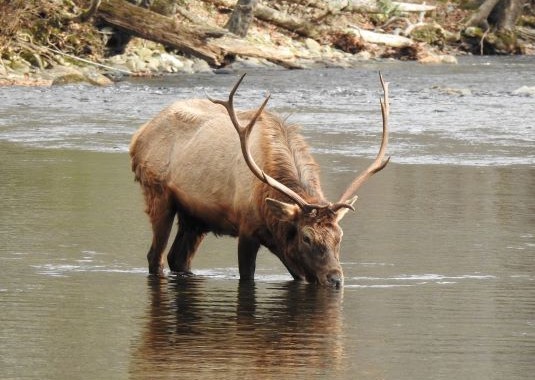There isn’t much that can entice me to venture out on Thanksgiving weekend, especially anything that involves heading toward Pigeon Forge or Gatlinburg. I’m just not into holiday-related traffic if it can at all be avoided.
But the chance to visit with a dear friend I hadn’t seen in 3 years sent me that way on Saturday. He had never seen much of the Smokies, so a trip into the national park was the order for the day. It was too late to attempt Cades Cove, so over the mountains we went: off to Oconaluftee to see the elk.
Once we got past the Sugarlands Visitor Center on 441, traffic kept getting thinner. It was a fairly uneventful journey, other than witnessing the bad behavior of influencers in the wild at the Newfound Gap Overlook (seriously, people, stop releasing balloons anywhere, and it’s illegal in the park).

Bull elk grazing along 441 in the Smokies (Photo by Beth Kinnane)
As we got closer to the Oconaluftee Visitors Center, we hit a stretch where we noticed cars to the side of the road. There was room to pull off, so we did (if there isn’t, keep it moving) and saw a lovely bull elk grazing in an open field along the edge of the woods. We got out, staying right by our car, and grabbed some pictures, then moved along for someone else to have a chance.
I told my buddy Billy that the coveted shot among amateur nature photographers like myself is catching a bull elk in the Oconaluftee River. Within five minutes of our arrival and hitting the river trail, there he was, a glorious, aged bull smack in the middle of the water, having a drink and cooling his jets. He was obviously a touch worse for wear from the recent rut, slightly favoring his left fore, which was swollen high up near his body. The left side of his face was also on the puffy side.
I have seen the elk here before as well as in the Cataloochee Valley, where the first herd was reintroduced to the Great Smoky Mountains National Park in 2001. But I had never gotten the chance at this particular photograph. The old man obliged my zooming and clicking for a sold five minutes before climbing out of the river on the opposite bank. Thank you, Prince of the Forest, thank you.
The return of elk to the Smokies is one of the success stories of bringing back what once seemed lost forever. The last eastern elk in Tennessee was killed in 1865. Most of the elk herds east of the Mississippi River were functionally wiped out by the early 1800s. While the elk we have now are Manitoban (the eastern subspecies is extinct), there is some current reconsideration of whether the eastern elk was actually a subspecies to begin with. Historical ranges of the eastern and Manitoban elk overlapped. So, subspecies or not, what we have now is pretty darn close.

Bull elk in the Oconaluftee River (Photo by Beth Kinnane)
Some attempts at reintroducing species to the Smokies didn’t work out so well, such as the critically endangered red wolf. None of the 40 pups born in Cades Cove survived, and the project was abandoned. But river otters and peregrine falcons have been successfully returned alongside protecting populations of brook trout and the fragile ecosystems that support hellbender salamanders (stop stacking rocks!) and little brown bats.
Other species that have been extirpated from the park (as well as most areas east of the Mississippi River) are unlikely to make a return. The American Bison is, at this point, impractical relative to population density and the necessary acreage of wide-open spaces they require. People lose their minds at the thought of bringing back charismatic mega fauna in the form of carnivores like the gray wolf and mountain lion. The Carolina parakeet has been extinct for nearly a century, the fox squirrel is MIA along with the green salamander, fishers and the red cockaded woodpecker, to name a few.
So have a care when you visit the park. Get an actual camera with a zoom lens. Don’t harass the wildlife children, and keep your trash to yourself. And don’t forget to drop some cash in a donation box.
Beth Kinnane is the community news editor for KnoxTNToday.com
Source: Great Smoky Mountains National Park

